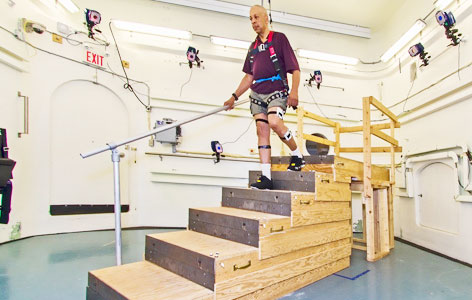
Falling on stairs is a common source of injury, particularly while going down a staircase. Each step down requires accurate foot placement while maintaining balance and stability to prevent toppling forward, due in part to the forward tilt of the upper body during descent.
Although falls on stairs can happen at any age, they are more prevalent among older adults. Little is known about the interactions between age, stair descent and stair design.
To address these relationships, TRI Scientist Dr. Alison Novak and colleagues initiated a study in which they measured the body movements of young and older adults while descending different sets of stairs; each set had a different length or height between the steps. Although the older adults had greater side-to-side movement of their upper bodies than younger adults, older adults also descended stairs more slowly so their steps were more stable. Conversely, the young adults exhibited less of a forward tilt of their upper body—decreasing their risk of falling forward—likely due to better balance control. For both age groups, the safest body posture occurred while descending stairs that were longer in length and shorter in height.
Dr. Novak's study explains how proper stair design can reinforce positive body movements that minimize the risk of falling. The research was used to inform upcoming changes to the National Building Code of Canada to improve stair design and safety; it is estimated that the changes will prevent 13,000 falls and 39 deaths due to stair-related falls over the next five years.
This work was supported by the Canadian Institutes of Health Research, the National Institute on Disability and Rehabilitation Research, the Ontario Graduate Scholarship Program and the Toronto Rehab Foundation.
Age-related differences in dynamic balance control during stair descent and effect of varying step geometry. Novak AC, Komisar V, Maki BE, Fernie GR. Applied Ergonomics. 2015 July 29. [Link to abstract]




